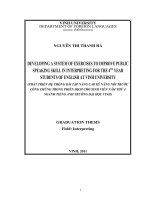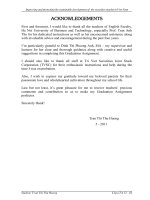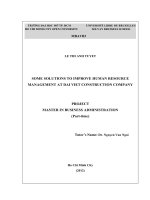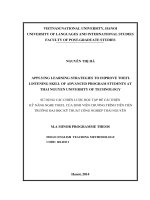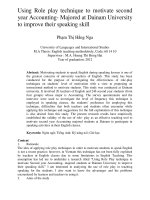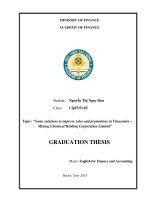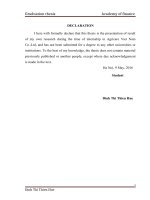The difficulties and some solutions to improve for speaking skill of level b english students in the center of foreign languages and informatics at ca mau community college
Bạn đang xem bản rút gọn của tài liệu. Xem và tải ngay bản đầy đủ của tài liệu tại đây (183.99 KB, 28 trang )
ACKNOWLEDGEMENTS
I would like to acknowledge the assistance I received from a number of people in the
course of carrying out the research paper. I highly treasure the important role they played in
making the completion of this thesis a success.
First of all, I am deeply indebted to my supervisor, Mr Nguyen Van Vinh for
painstakingly reading through my work from the beginning to the end and for his constants
advice and invaluable comments and suggestions. Without his continuous support I may not
have come this far.
Secondly, I want to express my thanks to the teachers of English at COFI at CMCC
who supplied me with basic and useful knowledge about how I could structure a research
project and what I should write in each chapter.
Thirdly, I wish to extend my special thanks to the students from B English class at COFI in
CMCC for their help and cooperation during my research at their class.
Last but not least, I owe my sincere thanks to my parents who have always inspired and
encouraged me to complete this study.
i
ABSTRACT
In Vietnam, English is one of the foreign languages that are compulsory from primary
school to university. However, teaching English to ethnic minority students has long been a
controversial issue. This research investigates the difficulties in English speaking skill
encountered by learners at COFI in CMCC with the hope to find out some suggested
solutions to the problems. The thesis is divided into 5 chapters: chapter 1 presents the
rationale, purpose, methods, research and significance of the study. Chapter 2 presents the
theoretical background of speaking, teaching and learning, and communicative language
teaching approach; Chapter 3 describes the methodology of the thesis. Specifically, the data
for this research was collected in the forms of survey questionnaires and. The participants of
the survey questionnaires were 4 teachers and 30 students. After the results of the survey
questionnaires had been clarified, Chapter 4 analyses and discusses the results from the
survey questionnaires. A lot of difficulties when teaching English speaking skill to learners
such as lack of time in using the new textbook, the poor teaching and learning conditions,
students' limited triangular language environment, low level of background knowledge, low
level of English proficiency, etc.; Chapter 5 mentions conclusions of this study, some
limitations, recommendations for further study and some pedagogical recommendations for
both subjective and objective problems. For example, the teachers should plan the speaking
lessons more carefully, improving the student’s Vietnamese competence. The teacher’s selfimprovement of speaking skill, educating teachers to teach English for their students in their
communities, Motivating students to learn, adapting the textbooks.... These recommendations
are expected to be beneficial to both teachers and students in COFI at CMCC.
ii
Table of Contents
ACKNOWLEDGEMENTS...........................................................................................i
ABSTRACT...................................................................................................................ii
LIST OF TABLES........................................................................................................iii
Chapter 1: INTRODUCTION.....................................................................................1
Chapter 2: LITERATURE REVIEW..........................................................................3
CHAPTER 3: METHODOLOGY...............................................................................8
CHAPTER 4. RESULTS AND DISCUSSION..........................................................10
CHAPTER 5: CONCLUTION AND IMPLACATIONS.........................................23
LIST OF ABBREVIATIONS
CMCC: Ca Mau Community College
COFI: Center Of Foreign Language and Informatics
N of Ts: Number of Teachers
N of Ss: Number of Students
CLT: Communicative Language Teaching
LIST OF TABLES
Table 1: Difficulties of students about learning speaking skill .............................................18
Table 2: Difficulties of teachers about teaching speaking skill .............................................19
iii
Table 3: Students attitudes towards English and facilities teaching and learning at COFI in
CMCC .....................................................................................................................................20
Table 4: Teachers attitudes towards English the materials teaching and learning at COFI in
CMCC .....................................................................................................................................22
Table 5: Students's for reasons learning English ...................................................................23
Table 6: Teachers methods in teaching English ....................................................................24
Table 7: Some solutions to improve speaking skill of teachers ............................................25
iv
Chapter 1: INTRODUCTION
1.1. Background to the study
In a short period of time English displaced other languages and became the leading
means of communication worldwide. Its domination continues to extend. The modern world
of media, mass communication, and Internet demands a good knowledge of English,
especially of spoken English. Every person wishing to get the benefits of modern education,
research, science, trade, etc., knows that it is impossible without a working knowledge of the
English language and good communication skills. A person without oral communication
skills will suffer in this era of competition and may find it difficult to achieve a higher
position. So, Center Foreign Language and Informatics at Ca Mau Community Colleges have
decided to establish, as the main purpose of English certificate level A, B, C the development
of the four skills: listening, speaking, reading and writing. Speaking is considered to be one
of the four macro skills necessary for effective communication in any language according to
most research, particularly when speakers are not using their mother tongue. But if you've
been learning for a while and don't find yourself really speaking with ease .Therefore, it is
reason why I choose the topic:
The difficulties and some solutions to improve speaking skill of B English students in
Foreign Language and Informatics center at CMCC
1.2. Statement of purpose
The aim of this article is to define the strengths and weaknesses of speaking skills of
today's students and to demonstrate the possibilities of enhancement of the speaking skills of
students learning English at Center for Foreign languages and Informatics in CMCC.
Base on the results of the current situation, I will give some solutions to improve
speaking skill for B English students in Foreign Language and Informatics Center at CMCC
1.3. Research questions
- What are your difficulties when learn speaking skill English in classes?
- How can you improve your English speaking skill?
1
1.4. Significance
This study help find out the practical solution to students can improve their weak points
and raise their speaking skill in learning English. It will help students learn more about the
disadvantages of Learning English communicative from which fix bugs have more
confidence in their English ability.
2
Chapter 2: LITERATURE REVIEW
2.1 Concepts of speaking
As mentioned above, speaking is the productive, oral skill. Speaking consists of
producing systematic verbal utterances to convey meaning (utterances are simply things
people say).
Speaking is an interactive process of constructing meaning that involves
producing and receiving and processing information (Florez, 1999, p.1). It is often
spontaneous, open-ended and evolving (ibid, p.1), but it is not completely unpredictable.
Speaking is such a fundamental human behavior that we don’t stop to analyze it unless
there is something noticeable about it. For example, if a person is experiencing a speech
pathology (if a person stutters or if his speech is impaired due to a stroke or a head injury),
we may realize that the speech is atypical. Likewise, if someone is a particularly effective or
lucid speaker, we may notice that her speech is atypical in a noteworthy sense. What we fail
to notice on a daily basis, however, are the myriad physical, mental, psychological, social,
and cultural factors that must all work together when we speak. It is even a more impressive
feat when we hear someone speaking effectively in a second or foreign language.
According to Brown and Yules opinions (1983), spoken language consists of short,
fragmentary utterances in a range of pronunciation. However, speaking is a skill, which
deserves attention as much as literacy skills in both first and second language because our
learners often need to speak with confidence in order to carry out a lot of their most basic
transactions (Bygate, 1991). Furthermore, speaking is known with two main types of
conversation called dialogue and monologue.
Brown and Yule (1983) point out the ability to give uninterrupted oral presentation
(monologue) is rather different from interacting with one or more other speakers for
transactional and international purposes. It is much more difficult to extemporize on a given
subject to a group of listeners. That explains why speaking skill generally has to be learnt and
practiced carefully before giving a presentation.
A comprehensive discussion of the nature of speaking is provided by Bygate (1987),
who shows that in order to be able to speak a foreign language, it is obviously necessary to
have micro-linguistic skills, that is, to understand some grammar, vocabulary and the rules
governing how words are put together to form sentences. However, these motor-perceptive
3
skills, as Bygate calls them, are not sufficient since while producing sentences, we often have
to adapt them to the circumstances. He then presents the second set of speaking skills: the
interaction skills, which involve using knowledge and basic motor-perception skills in
deciding what to say and how to say it, while maintaining the intended relation with others.
2.2. Characteristics of speaking
Speaking has the following characteristics:
Firstly, its form and meaning are dependent on the context in which it occurs, including
the participants themselves, their collective experiences, the physical environment, and the
purposes for speaking. It is often spontaneous, open-ended, and evolving. However, speech is
not always unpredictable. Language functions (or patterns) that tend to recur in certain
discourse situations can be identified and charted.
Secondly, speaking requires that learners not only know how to produce specific points
of language such as grammar, pronunciation, or vocabulary (linguistic competence), but also
that they understand when, why, and in what ways to produce language (sociolinguistic
competence).
Thirdly, speech has its own skills, structures, and conventions different from written
language. A good speaker synthesizes this array of skills and knowledge to succeed in a
given speech act.
Lastly, Bygate (1987) considers speaking as an undervalued skill in many ways. The
reason is that almost all people can speak, and so take speaking skill too much for granted.
He also asserts that speaking skill deserves attention every bit as much as literacy skills.
Learners often need to be able to speak with confidence in order to carry out many of their
most basic transactions. Bygate also highly appreciates speaking skill by stating that speaking
is the medium through which much language is learnt.
To sum up, it is undeniable that speaking is key to communication. By considering what
good speakers do, what speaking tasks can be used in class, and what specific needs learners
report, teachers can help learners improve their speaking and overall oral competency.
4
2.3. Situtions of teaching and learning speaking skill at COFI in CMCC
2.3.1 Condition of teaching and learning
The first and most easily found in an English class is now the student population. A
common class of not less than 40, with grades up to 50, 60. This figure often make school
educators and legal headaches are one of the most difficult question to answer in the system
COFI.
Besides visual media in foreign language classes are too poor. Most of the classrooms
are not equipped with video or audio recorder ... so fail to attract students to the native
environment, has not been real life into the classroom
2.3.2 .Attitude of student learning
Vietnam students often shy when speaking. They have no habit of arguing in class or
stated their opinion whether true or false, especially in the presence of teachers. Aerobic
classes are not pro attitude: you stand up and say the wrong one, the classmates often laughed
or revise sarcastically. This phenomenon has limited the participation of student lessons.
In class, students are usually very active, inclined to be positive than negative, chatting
or distracted in class was very popular. This behavior reflects very clearly in the language
class, the hour requires students to be involved in many different forms of training such as
training in pairs work, trained group, or honing their skills power requires students to move,
leaving space in the class ... These exercises so often creates confusion. And much as we feel
less of an effect does not depend on class engineering and enthusiasm of teachers in class,
mainly due to the attitude of student learning.
2.3.3. Methods of teaching and learning
The tradition of our teaching to bring the trend spreading information one way:
teachers, students take notes. Students often depend heavily on teachers: class, wanting to
say, recorded teachings that, on memorizing. Percentage of students learning attitude,
considering his discourses is only part of knowledge required, just the direction, very little.
This ingrained habit makes teachers often promote all of their ability to dominate classroom
time, students are also drawn back a modest way. Such learning can only be acceptable to
many theoretical courses, but learning a foreign language is a purely practical procedures and
practices to the clever, turning what he understood was what he used advantage.
5
Students, our students do not understand most of the English learning method how to
effectively, how to increase your vocabulary, how to listen understand who he said , using
the word what classic , listening with a few steps tapes ... this shows the learner should be
specified not only the road but also going further to match with the current trend of
integration.
2.4. Overview of previous studies
In this chapter, I will present some past researches in the same fields. There were many
opinions on English teaching and learning, such as:
In Viet Nam, like in many other countries, the problem of speaking skills is crucial. A
number of researchers investigated this field and came to the conclusion about students' low
level of speaking ability and their inability to speak confidently and fluently. One among the
many reasons to take into consideration might be the lack of confidence and anxiety about
making errors as stated by Trent (2009) and in other related studies. Most college students
are not confident in their ability to learn to speak; teachers must overcome their reluctance in
order to change this situation.
Zaremba and Zhang hypothesize that, of the four macro English skills, speaking seems
to be the most important skill required for communication (Zaremba, 2006). Students who
study English as a foreign language usually have limited opportunities to speak English
outside the classroom (Zhang, 2009) and also limited exposure to English speakers or
members of the international community. This might be one reason for teachers to provide
more situations and activities for students to strengthen their speaking competence.
Confidence and competence usually reinforce English speaking skills. Patil (2008)
asserted that building up the learner’s confidence to eliminate their fear of making errors was
a priority that a teacher should consider in order to make learners feel comfortable with their
language use. Confidence and competence in speaking could be developed from appropriate
syllabus design, methods of teaching, and adequate tasks and materials (Bailey, 2005;
Songsiri, 2007).
Regarding speaking effectiveness, Shumin (1997) pointed out a number of elements
involved, including listening skills, sociocultural factors, affective factors, and other
linguistic and sociolinguistic competences such as grammatical, discourse, sociolinguistic,
6
and strategic competence. Grammatical competence enables speakers to use and understand
English language structures accurately and unhesitatingly, which contributes to their fluency,
which, in turn, develops confidence in communication.
In the articles above are mentioned on disadvantages of English. However, they don’t
mention about solution to improve speaking skill English. Therefore, in my research, I would
like to mention some solutions to improve speaking skills English.
7
CHAPTER 3: METHODOLOGY
3.1. Time for the study:
From now April 7, 2014 to May 31, 2014.
3.2. Place for the study:
In the Foreign language and Informatics Center at CMCC.
3.3. Procedures:
-Firstly, I researched documents.
-Secondly, I read documents and collected information.
-Thirdly, I gave result and discuss.
-Finally, I finished my research.
3.4. Participants
In my investgation i sureyed 4 teacher and 30 students majored class level B English
students in COFI at CMCC
3.5. Purpose
The study is conducted to investigate the current reality of the teaching of speaking skill
to non-English major students at TNU-CT on the basis of finding out relevant difficulties
experienced by the teachers of English and some recommendations including coping
strategies and classroom techniques and activities for them to minimize those difficulties.
Specifically, this research tries to explore the potential sources causing the difficulties in
teaching the skill of speaking and simultaneously identify the specific problems of those
sources respectively. Furthermore, some recommendations are made with the anticipation of
helping English Language teachers improve the quality of their teaching the speaking skill.
8
3.6. Method
In order to achieve the aims mentioned above, the researcher collects information from
the teachers of English who have been teaching English at COFI in CMCC. Firstly,
questionnaires are delivered to the teachers so that more information on the reality and
problems they face and solutions implemented can be collected. Then, questionnaires are also
given to the students to investigate their problems in learning speaking skills. The
information from questionnaires can help to draw a general picture about the reality of
teaching and learning speaking skills at COFI in CMCC and suggest some solutions for this
situation.
9
CHAPTER 4. RESULTS AND DISCUSSION
4.1. Overview about the COFI
Center of Foreign language and Information was established in 1998 with the first name
is Foreign language and Informatics Office of Center for Continuing Education (now is the
COFI of CMCC). It has the function of training about English and Information technology in
order to meet the requirement of local people, contribute to development of Ca Mau.
For the first time in operation, the COFI faced many difficulties and challenges. From
the stage of promotion, opening enrollment classes to the lack of faculty forces, quality and
professional work experience is limited. Especially, infrastructure and equipment to support
for
teaching
did
not
have
conditions
to
equip
...
Given the problems in operation, The COFI has been closely guided by the Party
Committee, Managing Board, the active support of the offices, faculties, departments and
staffs in CMCC . The generation of managers and staffs have overcome the difficulties and
limitations to make solid foundation to build long -term development plan for the center.
Up to now, over 15 years of construction and development, the COFI has achieved
many positive results, the prestigious of center was confirmed and evaluated in high training
quality
and
the
quality
of
teaching
staff.
On the basis of material : The COFI has fully equipped about modern facilities and
computer rooms , labs , projectors , and many other equipment combinations to create
friendly learning environment to serve for teaching and learning better. Specifically, the
computer lab (room 05 with over 125 machines) connected to high-speed Internet, all
classrooms are equipped with air conditions , multi-function projectors.
The center have been 17 classes of English Certificate in level A, B, C, and 18 classes
of Informatics Certificate in level A, B. The center aims to meet the learners demand for
studying and upgrading knowledge of foreign language and information particularly in Ca
Mau Community College.
10
4.2. Questionnaires
This section of the thesis is the treatment of the data collected from the survey
questionnaires conducted on 5 teachers and 30 students
This part will present the analysis of the data collected from the English teachers and
the students of class level B English at COFI in CMCC. All the statistical data will be shown
in the form of percentages. Among 1,2,3,4 questions for the students, as to questions 5,6,7,8
for the teachers Therefore, the results for the questions are presented in the percentage of the
options chosen.
In which, questions 1 and 5 in the teachers and students survey questionnaires are
designed to ask about the difficulties of teaching and learning speaking skill.
Questions 2-3-6 are about the teachers and students attitudes towards English subject,
the speaking skill, the materials and facilities teaching and learning at COFI in CMCC.
Question 4 are about the students reasons for learning and question 7 are methods of
teachers for teaching English in COFI
The questions 8 in the teachers survey questions about some solutions to improve
speaking skill for students
11
Question
N of Ss
%
A. You aren't interested.
5
16
B. Large classes and no equivalent
3
10
C. Ability to speak English well you
5
17
D. You lazy
10
35
E. Inappropriate curricula
2
7
F. You don't enough time to clearn.
1. What is often your
Answer
4
15
encounter difficulties
have not
Table 1: Difficulties of students about learning speaking skill
12
Question
Answer
N of Ts
%
A. Students low motivation
2
12
B. Students low level of English
3
45
C. Time limitation.
0
0
D. Students laziness.
2
16
E. Large and heterogeneous class.
1
12
F. Inappropriate materials.
0
0
G. Poor teaching equipments.
1
10
H. Others (please specify)......
0
0
proficiency.
5. What are your
difficulties in
teaching speaking
skills ?
13
Table 2: Difficulties of teachers about teaching speaking skill
From table 1 and 2 the collected data above, we can come to conclusion that the
teachers and students face many difficulties during the process of teaching and learning
speaking. For the students at COFI, the biggest factor that prevents them from expressing
their ideas is their low level of English proficiency (45%). Only 11% of the students isn't
interested. The students (35%) and teachers (16%) blame that the students laziness is another
factor that deter the students to speak. As well, the low motivation of the students in
participating class speaking activities is believed one of the difficulties by 12% of the
teachers and 13% of the students. The number of teachers and students which accounts for
12% and 12% respectively complains that it is so hard to express themselves in a large and
heterogeneous class. The teachers and students also say inappropriate materials, poor
speaking equipments, or time limitation are the obstacles for teaching and learning speaking
skills.
In conclusion, pair works or group works in the final stage are highly appreciated by
both of the teachers and students. This activity would be a great step if the teachers know
how to control the class well in the previous stages as well as to check and assess the students
speaking competence.
14
Question
2. Do you are
Answer
N of Ss
%
A. Yes
30
100
B. No
0
0
C. Only a few teaching facilities
0
0
14
46
B. Important
15
49
C. Little important
1
5
equipped with
modern teaching
facilities such as
radios, televisions,
computers, VCRs,
projectors etc. To
cater for teaching
3. What English? A. Very important
speaking is your
views on learning
to speak English in
class?
D. Not important
0
15
Table 3: Students attitudes towards English and facilities teaching and learning at COFI in
CMCC.
There are many reasons why the students at COFI do not willingly spend much time on
speaking skills in classes but one of those reasons comes from the present facilities used in
class. According to the data in the table above, we can conclude the students of COFI have a
negative opinion about the teaching and learning sources. Moreover, nearly 100% of them
say that the English Department offers only radios but not other modern equipment like
computers, projectors, T.V, video recorder, etc to make the speaking activities in class more
exciting
Surprisingly, the statistical results from question 3 above revealed that students in
general attached to speaking a considerable importance, that is, up to 45. 8% and 49.2% of
the students stated that speaking skill is a very important and rather important skill
respectively whereas only 5% of them supposed speaking skill is little important. Such a high
rating of speaking with students may stem from the reason which may be connected with the
demands of today’s society where the ability to speak at least one foreign language means a
necessity. This requirement together with the position of English as a world language may
account for a strong position of speaking within language learning. A good command of a
language is considered an investment in a future life as it may extend one’s opportunities in
looking for a decent and well-paid job or in further studies. There may be an influence of
popular culture with songs in English and English-speaking media (e.g. the internet, TV and
radio channels). Also, while studying, working or traveling abroad a good speaking skill
proves to be a great advantage. From this fact, it can be concluded that the majority of the
students are aware of the importance of the speaking skill. However, the question raised here
is that what the reasons or factors that make students reticent in oral English classes are and
what teachers should do to motivate the students to speak.
16
Question
Answer
N of Ts
%
6. What do you
A. Difficult and boring.
4
65
think of the
B. Difficult but interesting.
2
20
C. Interesting and stimulating.
1
13
D. Easy and boring.
3
47
materials used for
teaching and
learning speaking
skill at COFI?
Table 4: Teachers attitudes towards English the materials teaching and learning at COFI in
CMCC
From the data in the table above, nearly half of the 65% teachers admit that the present
material are not only difficult but also boring. The topics of some lessons such as
introduction about yourself, family, food and drink are repeated in different levels, which
make both the students and teachers find it boring. In contrast, they find difficult to deal with
some complicated topics like cultures, environment, transportations or health problems. On
17
the other hand, 20% teachers state that the current materials difficult but interesting. 13% of
the teachers consider these materials are interesting and stimulating because they can
discover new and useful things after each lesson so that they can widen their knowledge. The
teachers (47%) have the same opinion that their materials are easy and boring. From the fact
above, we can conclude both the teachers and the students of COFI have a negative opinion
about the teaching and learning sources.
No of
students
Question Options
6. Why A. Obligatory subject in university curriculum
21
do you
B. Interested in English or enjoy learning English
7
learn
27
English? C. Extend future opportunities, i.e. jobs, promotion etc.
(Tick
D. For the purpose of entertainment such as listening to
more
music, playing games, reading books, magazines,
8
than one newspapers…in English
option)
E Widen your knowledge about countries in the world
(i.e. to learn about the language and culture of English 9
speaking countries)
(%)
72.5
23.3
85
24.2
25
F. An important means of communication
18
68.3
G. Others
0
0
Table 5: Students for reasons learning English
As can be seen from Table 5, a relatively great proportion of COFI at CMCC students
(68.3%) responded that they learned English because it’s an important means of
18
communication. This means that nowadays it is important to be able to speak a foreign
language, especially English. This demand is connected with the position of English as an
international language. Speakers of English, in their opinion, were able to communicate and
be understood almost in all situations and places all over the world. A frequent students
answer (72.5%) was that they had to learn English since it forms one of the obligatory
subjects in the universities’ and colleges’ curriculum. These results suggest that student
motivation for learning English arises, in a large extent, from external stimuli, i.e. the
requirements of their universities and colleges and demands of the contemporary society in
general. Thus, the student motivation, in its prevailing part, can be characterized as extrinsic.
Moreover, the reason for learning English that recurred in students responses was that they
would need English in their future lives, e.g. in their future profession, when studying,
working or traveling abroad. In short, they need English in order to extend their future
opportunities. Upon scanning the results, it becomes apparent that the reason connected to
extending future opportunities gained in prominence with the approval of 85% of the
students. The students increasing awareness and reflecting on the future possibilities, e.g.
studies or career orientation, may account for this fact. The stimulus for learning English in
order to extend future opportunities may be classified as belonging to extrinsic, instrumental
category of motivation. It may be concluded that in general the student motivation for
learning English is extrinsic. However, there may be the intrinsic motivation, arising from a
genuine interest in English, detected in a much smaller proportion of students (23.3%).The
findings here revealed that extrinsic, instrumental motivation seemed to outweigh intrinsic,
integrative motivation as a drive to learn. However, to succeed in learning English, the
students need to be intrinsically motivated as well. To conclude again, the students at
CODING in CMCC still have low motivation of speaking English in class.
19
Options
No of
Ts
(%)
CLT
3
60
Audio-lingual method
1
15
Grammar-Translation method
5
100
Direct method
2
45
Others
0
0
Questions
7. What teaching
methods are
currently applied in
your teaching
speaking?
Table 6: Teachers methods in teaching English
The statistics from Table 1 clearly shows that all the teachers of English at COFI preferred
applying Grammar-Translation method in their teaching to applying CLT approach (60%) or
others. But the teachers was rarely applied in teaching English in general and teaching
speaking in particular (100%). In consistent with the statistical results above, the student
claimed that the teacher mainly focused on explaining and giving the forms of grammar
structures and providing the meaning of vocabulary, or in other words, the goal of teaching
was set on grammar accuracy, speaking fluency was neglected. As a result of traditional
methods, teachers occupied more class-time than students; hence, the students were not given
significant time and encouragement to develop their self-confidence and their speaking
ability.
20
Question
Answer
N of Ts
%
A. Ask students to learn by heart all
2
60
1
30
1
10
to
1
20
E. Suggest students taking an English
4
90
3
75
learnt vocabulary and structures.
B. Ask students to practise English
everyday.
C. Ask students try to speak as much
English as possible.
D.
Advise
students
try
communicate with native speakers.
course in Foreign language Centers.
F. Others ( please specify
21
